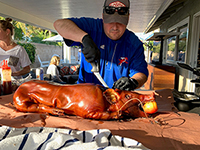You’re on hold with the IRS. What will you do with your time?
Mike Giangrande, J.D., LL.M.
Federal Tax Editor
There’s about a month of tax season left, so when you end up on hold with the IRS, there’s no time for idly staring into space while you wait hours for them to get on the line. Instead:
- Drink a 32oz coffee.
- Try to run to the bathroom and back before the IRS picks up.
- Watch the voicemails pile up while the phone is in use.
- Wonder if I should have just used the call-back feature instead of waiting on hold, then remember that I don't have a direct-dial line in my office, so when the IRS calls back, I have to hear my secretary run down the hall asking who called the IRS before the agent gets tired of waiting and hangs up.
- Dream of killing the person who came up with the IRS’s hold music that hasn’t changed in my entire 23-year career.
- Rethink my life choices as I try to figure out how to bill my client for this colossal waste of my time (see “Sample client letter: Why your bill just went up 1000%” in the February 27 issue).
- Try to get other work done.
- Pray that the IRS picks up and will be able to handle my issue before my next client appointment — three hours from now.
- Secretly binge-watch Breaking Bad, season 3… again.
- Write Spidell’s entire fall update manual.





 Austin Lewis traveled to four national parks in nine days last summer, and here he is at the Grand Canyon. Pro tip: The north rim has 10x better views and 10x fewer visitors than the south rim.
Austin Lewis traveled to four national parks in nine days last summer, and here he is at the Grand Canyon. Pro tip: The north rim has 10x better views and 10x fewer visitors than the south rim.
 Diane Fuller loves to read, cook, and go to Ketchum/Sun Valley, Idaho, as many times as possible during the year with her family including grandkids and dogs.
Diane Fuller loves to read, cook, and go to Ketchum/Sun Valley, Idaho, as many times as possible during the year with her family including grandkids and dogs.
